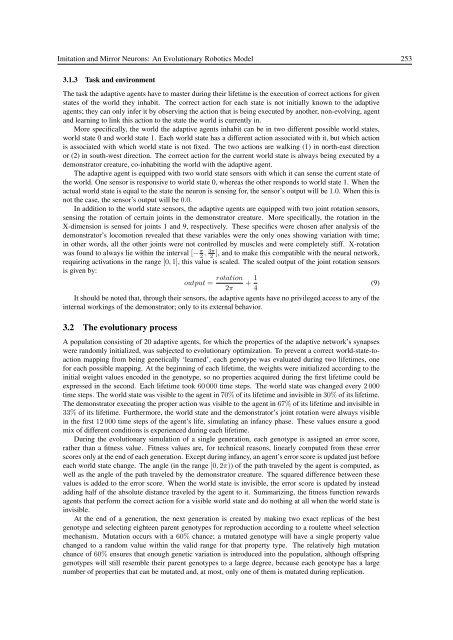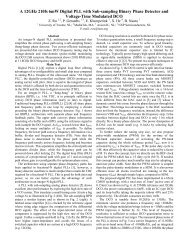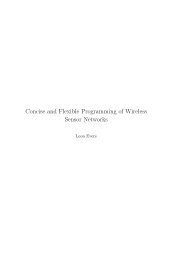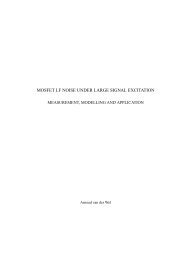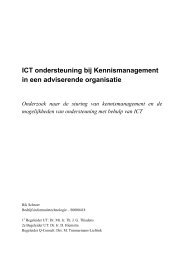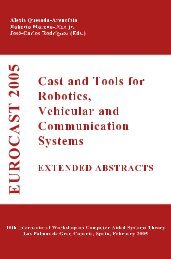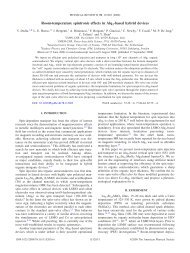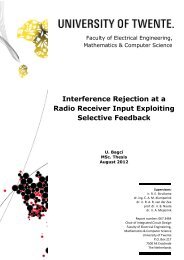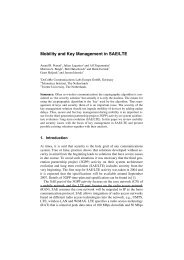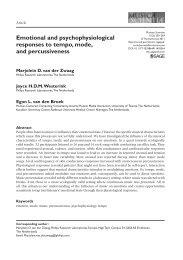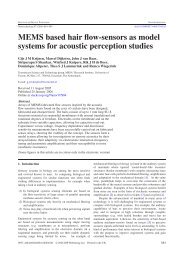extended - EEMCS EPrints Service - Universiteit Twente
extended - EEMCS EPrints Service - Universiteit Twente
extended - EEMCS EPrints Service - Universiteit Twente
Create successful ePaper yourself
Turn your PDF publications into a flip-book with our unique Google optimized e-Paper software.
Imitation and Mirror Neurons: An Evolutionary Robotics Model 253<br />
3.1.3 Task and environment<br />
The task the adaptive agents have to master during their lifetime is the execution of correct actions for given<br />
states of the world they inhabit. The correct action for each state is not initially known to the adaptive<br />
agents; they can only infer it by observing the action that is being executed by another, non-evolving, agent<br />
and learning to link this action to the state the world is currently in.<br />
More specifically, the world the adaptive agents inhabit can be in two different possible world states,<br />
world state 0 and world state 1. Each world state has a different action associated with it, but which action<br />
is associated with which world state is not fixed. The two actions are walking (1) in north-east direction<br />
or (2) in south-west direction. The correct action for the current world state is always being executed by a<br />
demonstrator creature, co-inhabiting the world with the adaptive agent.<br />
The adaptive agent is equipped with two world state sensors with which it can sense the current state of<br />
the world. One sensor is responsive to world state 0, whereas the other responds to world state 1. When the<br />
actual world state is equal to the state the neuron is sensing for, the sensor’s output will be 1.0. When this is<br />
not the case, the sensor’s output will be 0.0.<br />
In addition to the world state sensors, the adaptive agents are equipped with two joint rotation sensors,<br />
sensing the rotation of certain joints in the demonstrator creature. More specifically, the rotation in the<br />
X-dimension is sensed for joints 1 and 9, respectively. These specifics were chosen after analysis of the<br />
demonstrator’s locomotion revealed that these variables were the only ones showing variation with time;<br />
in other words, all the other joints were not controlled by muscles and were completely stiff. X-rotation<br />
was found to always lie within the interval [− π 3π<br />
2 , 2 ], and to make this compatible with the neural network,<br />
requiring activations in the range [0, 1], this value is scaled. The scaled output of the joint rotation sensors<br />
is given by:<br />
output = rotation<br />
+<br />
2π<br />
1<br />
(9)<br />
4<br />
It should be noted that, through their sensors, the adaptive agents have no privileged access to any of the<br />
internal workings of the demonstrator; only to its external behavior.<br />
3.2 The evolutionary process<br />
A population consisting of 20 adaptive agents, for which the properties of the adaptive network’s synapses<br />
were randomly initialized, was subjected to evolutionary optimization. To prevent a correct world-state-toaction<br />
mapping from being genetically ‘learned’, each genotype was evaluated during two lifetimes, one<br />
for each possible mapping. At the beginning of each lifetime, the weights were initialized according to the<br />
initial weight values encoded in the genotype, so no properties acquired during the first lifetime could be<br />
expressed in the second. Each lifetime took 60 000 time steps. The world state was changed every 2 000<br />
time steps. The world state was visible to the agent in 70% of its lifetime and invisible in 30% of its lifetime.<br />
The demonstrator executing the proper action was visible to the agent in 67% of its lifetime and invisible in<br />
33% of its lifetime. Furthermore, the world state and the demonstrator’s joint rotation were always visible<br />
in the first 12 000 time steps of the agent’s life, simulating an infancy phase. These values ensure a good<br />
mix of different conditions is experienced during each lifetime.<br />
During the evolutionary simulation of a single generation, each genotype is assigned an error score,<br />
rather than a fitness value. Fitness values are, for technical reasons, linearly computed from these error<br />
scores only at the end of each generation. Except during infancy, an agent’s error score is updated just before<br />
each world state change. The angle (in the range [0, 2π)) of the path traveled by the agent is computed, as<br />
well as the angle of the path traveled by the demonstrator creature. The squared difference between these<br />
values is added to the error score. When the world state is invisible, the error score is updated by instead<br />
adding half of the absolute distance traveled by the agent to it. Summarizing, the fitness function rewards<br />
agents that perform the correct action for a visible world state and do nothing at all when the world state is<br />
invisible.<br />
At the end of a generation, the next generation is created by making two exact replicas of the best<br />
genotype and selecting eighteen parent genotypes for reproduction according to a roulette wheel selection<br />
mechanism. Mutation occurs with a 60% chance; a mutated genotype will have a single property value<br />
changed to a random value within the valid range for that property type. The relatively high mutation<br />
chance of 60% ensures that enough genetic variation is introduced into the population, although offspring<br />
genotypes will still resemble their parent genotypes to a large degree, because each genotype has a large<br />
number of properties that can be mutated and, at most, only one of them is mutated during replication.


